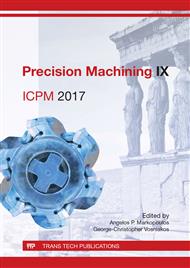[1]
A. Janáč, B. Bátora, I. Baránek, Z. Lipa, Technológia obrábania (Technology of machining), Slovak University of technolgy, Bratislava, 289p, (2004) ISBN 80-227-2031-3.
Google Scholar
[2]
K. Vasilko, Teória a prax trieskového obrábania (Theory and practice of machining), Faculty of manufacturing technology in Kosice, 532p. (2009), ISBN-978-80-553-0152-5.
Google Scholar
[3]
R. Voß, M. Henerichs, F. Kuster, K. Wegener, Chip Root Analysis after Machining Carbon Fiber Reinforced Plastics (CFRP) at Different Fiber Orientations, Procedia CIRP, Volume 14, pp.217-222, (2014), ISSN 2212-8271.
DOI: 10.1016/j.procir.2014.03.013
Google Scholar
[4]
G. Sutter, Chip geometries during high-speed machining for orthogonal cutting conditions, International Journal of Machine Tools and Manufacture, Volume 45, Issue 6, pp.719-726, (2015), ISSN 0890-6955.
DOI: 10.1016/j.ijmachtools.2004.09.018
Google Scholar
[5]
M. Neslušan, I. Mrkvica, R. Čep, M. Čilliková, Influence of cutting speed on intensity of the plastic deformation during hard cutting, Inst za kovinske materiale i in tehnologie, (2013), ISSN: 1580-2949.
Google Scholar
[6]
J. Duplák, A. Panda, M. Kormoš, I. Pandová, S. Jurko, Evaluation of T-vc dependence for the most commonly used cutting tools, Key Engineering Materials, 669, pp.311-318, (2016), ISSN: 1662-9795.
DOI: 10.4028/www.scientific.net/kem.669.311
Google Scholar
[7]
J. Beňo, I. Maňková, M. Vrábel, B. Karpuschewski, T. Emmer, K. Schmidt, Operation Safety and Performance of Milling Cutters with Shank Style Holders of Tool Inserts, Procedia Engineering, Volume 48, Pages 15-23, (2012), ISSN 1877-7058.
DOI: 10.1016/j.proeng.2012.09.479
Google Scholar
[8]
S.A. Saltykov, Steremetricheskaya Metallograpfiya (Stereometric Metallography), 2nd revised and supplemented edition, Metallurgizdat, Moscow, 444 pgs, (1958).
Google Scholar
[9]
Řehoř, J., Fulemova, J., Monková, K., Monka, P. Morphology of the chip formation at orthogonal high speed milling of AISI H13, (2016) Key Engineering Materials, 686, pp.45-50.
DOI: 10.4028/www.scientific.net/kem.686.45
Google Scholar
[10]
Wagner, V., Vissio, A., Duc, E., Pijolat, M. Relationship between cutting conditions and chips morphology during milling of aluminium Al-2050, (2016) International Journal of Advanced Manufacturing Technology, 82 (9-12), pp.1881-1897.
DOI: 10.1007/s00170-015-7490-7
Google Scholar
[11]
Niu, Q., Li, P., Chen, M., Ming, W., Tang, S. Analysis of chip serration phenomenon in side milling of ultrahigh-strength steel 30CrMnSiNi2A, (2017) International Journal of Advanced Manufacturing Technology, 88 (1-4), pp.985-993.
DOI: 10.1007/s00170-016-8832-9
Google Scholar


